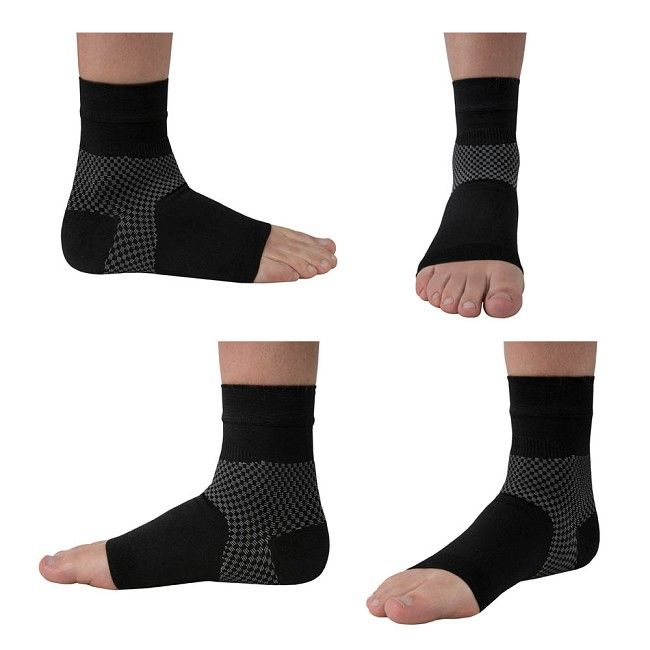 Written by Mike Price, OT
Written by Mike Price, OT
Compression therapy is one of the most commonly applied methods to treat and prevent a wide variety of musculoskeletal injuries and circulatory conditions. At the most basic level, compression devices utilize consistent pressure to reduce pain and inflammation and promote healthy fluid circulation.
The most common form of these devices is the compression sock or elastic bandage, providing relief from twisted or swollen ankles, but compression is growing in popularity as more and more people realize its versatility and efficacy at preventing injury and relieving pain. And as it grows in popularity, the market is growing in tandem, giving customers an array of braces, shirts, sleeves, pants, socks, and bandages to choose from for any and every need they may have.
But with the wide variety available, navigating the choices might be a confusing job for someone just looking for a solution. Luckily, Rehabmart is here to help. We’ll outline the different levels of compression available, types of garments on the market, and how to choose the right ones for your needs so that your shopping experience is effortless.

Compression devices are available in five levels, offering pressure that ranges from 8 to 50 mmHg, and each level designed for specific tasks and patient needs. Your choice of level depends on the severity of the pain, the medical condition being treated, and your unique preferences.
Mild compression is the lowest level of compression available, and likely the one that is most familiar. Mild compression devices provide light pressure (between 8-15 mmHg) designed to help relieve soreness in aching joints and body areas, and provides mild circulatory stimulation that can help prevent varicose and/or spider veins.
Medium compression ranges from 15 to 20 mmHg and is typically used to provide relief for more severe aches and pains either in the muscles or joints. It is also ideal for use in long-distance travel to improve circulation and relieve the stiffness and soreness associated with traveling and long periods of time being cramped and stationary.
Firm compression, ranging from 20 to 30 mmHg, is the level at which compression garments are no longer intended for relieving soreness or achy muscles and joints. Instead, firm compression is typically used to promote the circulation of blood or lymphatic fluids. Because of this, it is frequently used for patients in a postoperative setting, wherein circulation may be decreased, or for medical conditions like diabetic neuropathy or blood pooling in the feet.
Extra firm compression, characterized by 30 to 40 mmHg, is used to relieve many of the same conditions as firm compression, just providing more pressure for larger patients or more severe symptoms. It can be used to promote circulation, relieve hypertension, and treat severe edema.
Medical-grade compression provides the highest level of pressure available, ranging from 40 to 50 mmHg and is only used in medical treatment and rehabilitation. Often seen only in compression stockings and thromboembolic deterrents, medical compression can only be obtained with a prescription and is used mostly for post-surgical conditions to prevent the pooling of the blood or other circulation problems that might be observed in patients with limited mobility.

Due to the variety of conditions and body regions that compression can be used to benefit, the selection of compression devices is equally vast. Thankfully for the buyer, that means there’s a perfect compression garment or device for any and every need they may have, helping to prevent soreness or relieve joint swelling, encourage circulation or prevent varicose veins.
Compression bandages are specially-designed strips of woven elastic fabric that help relieve pain and swelling associated with a variety of soft tissue injuries through the application of compression. The versatility of these bandages allows you to easily wrap them around any injured or sore region of the body, fitting any location or body size with ease.
These bandages come in all widths and lengths, and some, like the Kin-Grip Tubular Compression Bandages are even made so that they don’t require the use of adhesives or clips and can be machine washed and reused again and again.
Compression socks and stockings are probably the most familiar type of compression device, providing pain relief and circulatory support for the feet and legs. These devices are composed of a strong, but breathable material that applies compression without significantly limiting airflow. For fluid circulation, these garments apply graduated compression to pump fluid from the feet back towards the body, and are available in multiple designs for both men and women.
Compression sleeves, also called compression braces, are either short or long tubes of compression fabric that apply compression around 360-degrees of a joint or limb. Commonly used to support the knees and elbows, compression sleeves are also available in designs that cover the calf, arm, wrist, feet, or ankle, applying firm, even pressure to help users move comfortably and relieve the aches and pains of swollen joints and sore muscles.
Compression gloves are most often used to treat the aches and pains of conditions like arthritis, carpal tunnel syndrome, and Raynaud’s. These thin, comfortable gloves apply even compression over the small joints of the hand and fingers, and help to insulate the joints with to soothe away aches and pains. A variety of designs are available to ensure maximum comfort for a range of user needs, full hand, fingerless, short, or long enough to cover the wrist.
As their name implies, compression garments fit snugly to a specific limb or body area to apply pressure. Choosing a compression garment depends mostly on:
The intersection of these three factors provides a good compass for which garment or device will best suit your unique needs. For example, a golfer with a sore elbow might choose a mild or medium compression elbow sleeve, while someone who has to be on their feet all day, lifting and moving heavy equipment might choose medium compression socks and maybe compression knee braces as well.
People living with lower body edema might choose firm or extra-firm compression socks or a pair of tights or stockings, helping to promote the circulation of blood and other fluids from the legs, where it may otherwise pool or cause swelling.
However, certain other factors like age and weight might contribute to unique requirements, so if you’re using compression to treat a specific medical condition, it’s always a good idea to discuss the decision with your doctor before making a final selection.
Ultimately, compression garments help to improve circulation and decrease swelling or edema. They can also stabilize certain muscles, joints, or other structures to help relieve pain.
Unless you're dealing with some sort of injury, wound, or functional disability, then no. The effects of compression garments on athletic performance in healthy individuals have been largely inconclusive. Compression garments will, however, improve workout recovery by improving circulation and helping to reduce delayed onset muscle soreness when worn after you exercise.
Compression socks, and any other compression garment, should feel like a tight squeeze, but should not painful to wear or move around in.
Unless your doctor tells you otherwise, avoid wearing compression bandages or garments while you sleep. Keep the area elevated if you can to help reduce swelling, but avoid sleeping in compression gear.
Rehabmart proudly offers a wide selection of products from trusted medical equipment manufacturers such as Kinship Comfort, BSN Medical, and Juzo, providing compression braces, sleeves, stockings, gloves, and bandages of all kinds to accommodate any and every need you might have. Whether you’re just researching or ready to make your final purchase, visit us at Rehabmart.com for more information.

Co-Founder of Rehabmart and an Occupational Therapist since 1993. Mike has spent his professional career working in multiple areas of Occupational Therapy, including pediatrics, geriatrics, hand therapy, ergonomics and inpatient / outpatient rehabilitation. Mike enjoys writing articles that help people solve complex therapeutic problems and make better product choices.